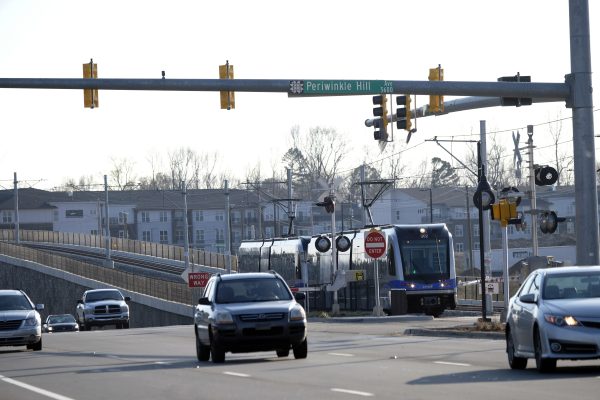‘You can only make roads so big’: Charlotte region launches first transit plan

Leaders from across the region gathered Monday in a conference room at Charlotte Douglas International Airport with an ambitious goal: Creating a comprehensive plan for public transit, covering a dozen counties and setting the transit agenda for decades.
Called CONNECT Beyond, the 18-month planning effort by the Centralina Council of Governments is, to put it simply, big. The planning area covers 12 counties, in two states, with 17 different transit systems. Previous transit planning efforts have been focused mostly on one county at a time. The goal here is to come up with a plan to coordinate and prioritize projects, as well as funding requests, across the whole region.
“Twenty years from now, I think everyone is going to look back on this as the jumping-off point,” said John Muth, the Charlotte Area Transit System’s chief development officer.
Participants talked about light rail, commuter rail, self-driving cars, autonomous drone taxis, scooters, sidewalks and bicycles. The need to think big and break down the silos and jurisdictional lines was a constant refrain. They worried about whether growth could someday morph from Charlotte’s blessing to the city’s curse, as more and more people clog congested thoroughfares, unless we invest more in transit now. And local leaders emphasized the need for small, incremental changes (say, increased express bus service and fare systems that work across counties) to help people see actual changes.
[Read more: Charlotte is ‘on the cusp’ of its first true regional transit plan]
The plan will build on CCOG’s earlier public transit studies, as well as the Charlotte Area Transit System’s 2030 plan. But it is broader in scope geographically than the CATS plan, and, organizers say, will be more detailed than earlier CCOG efforts.
CONNECT Beyond will focus on all modes of public transit (light rail, commuter rail, buses, etc.), while recommending continued investment in mobility options such as improved pedestrian and bicycle infrastructure. The goal is to have a detailed plan with specific priorities and high-traffic corridors identified in about 1 ½ years.
At the @CentralinaPlan kick off for the region’s first transit plan. Balancing “big ideas with small moves” (long and short term) will be key to getting real movement. #transit pic.twitter.com/Ezoqi3Ef7u
— Ely Portillo (@ESPortillo) February 24, 2020
Over the coming months, the group (which includes representatives from local governments and transit agencies across the region) will have to grapple with some key questions. Among them:
Who will govern a regional system?
CATS is the biggest transit agency involved in the regional plan, but its jurisdiction only covers Mecklenburg County. Although the east-west Silver Line light rail line is envisioned running to Gaston and Union counties, there isn’t a truly regional governance model for operating such a system. The Metropolitan Transit Commission, CATS’ policy board, includes some non-voting, regional members from outside Mecklenburg in an advisory capacity.
What modes will a regional system use?
An ambitious regional transit plan might bring to mind images of Denver, building more than miles of new rail lines across eight counties in one swoop. But leaders at Monday’s meeting emphasized that rail lines will only be one component of the eventual plan. CATS chief executive John Lewis said buses will be a significant part of the plan (don’t forget, buses still carry the majority of CATS’ customers), and other leaders said the plan needs to make allowances for new technology, like autonomous vehicles, for first-mile/last-mile connectivity.
How can leaders maintain interest?
Eighteen months is a long time, and the timeline for implementing an actual plan will be even longer, likely decades. Given that, leaders emphasized the need to ensure people stay interested in the plan so it doesn’t just sit on a shelf. Several people at the meeting said transit officials need to find small changes they can make soon — such as giving buses dedicated lanes or traffic signal priority, and designing a regional fare system that works across counties — in order to demonstrate some short-term benefits.
Who will pay?
The biggest questions for any new transit plan revolve around money: How much will it cost, and who will pay? CATS is largely funded by a half-cent sales tax in Mecklenburg County, which supplied $108 million in revenue last year. The Blue Line light rail construction was funded by federal, state and local allocations, with the federal government picking up the biggest share of the tab.
CATS is already looking for billions of dollars to fund the Silver Line and future extensions of the Blue Line. Any true regional system will require true regional funding. Will voters in Gaston and Union counties vote in favor of a sales tax? What about Iredell and Lincoln? How about across the state line, in South Carolina?
Funding questions are likely to be the thorniest, especially with state and federal money in flux.
But on Monday, optimism suffused the room.
“We’re just beginning,” said Charlotte Mayor Vi Lyles. “We’re going to start talking about mobility as a vision.”